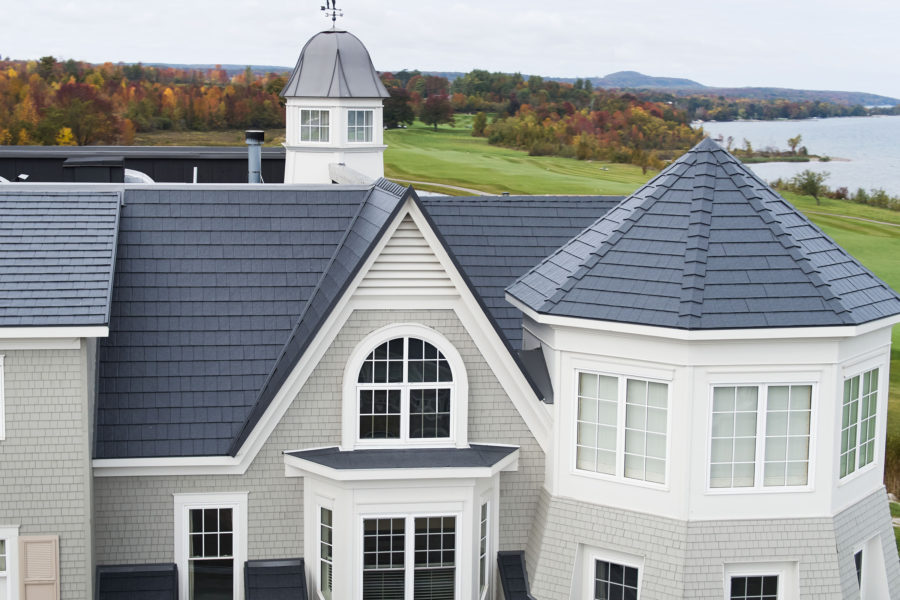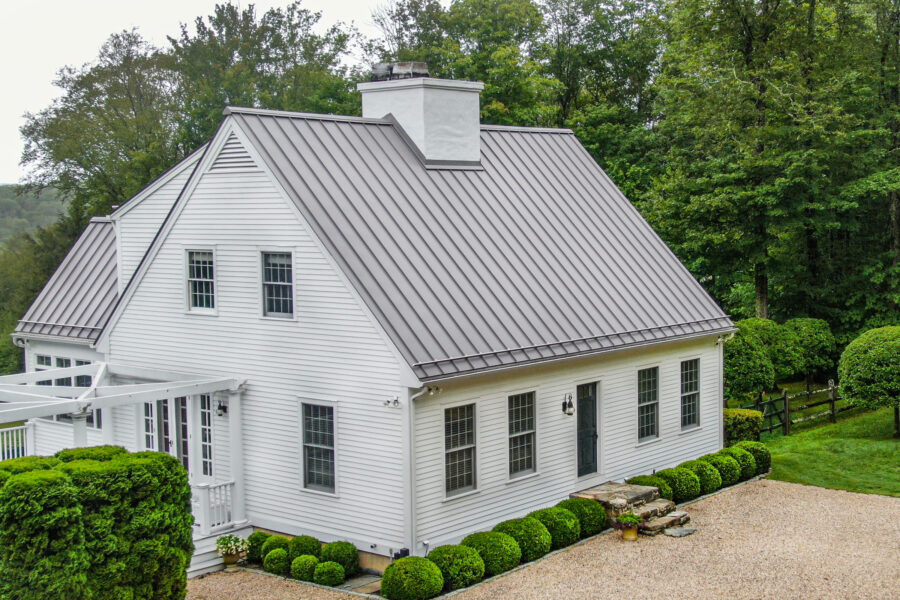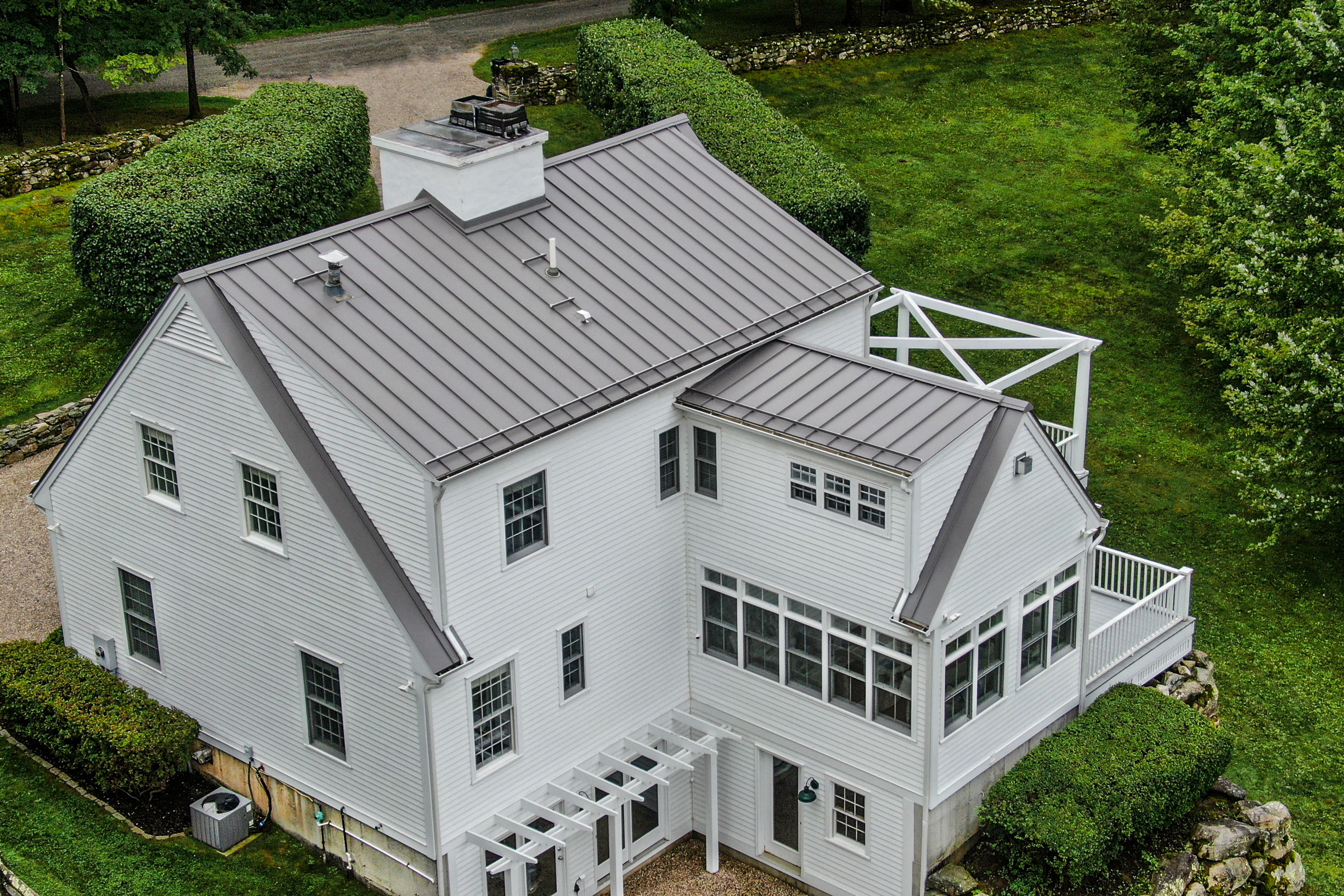Story at a glance:
- Both aluminum and steel are highly recyclable building materials suitable for roofs and siding, while steel cannot be surpassed for structural frames.
- Paints and pigments applied to surfaces enhance the energy efficiency of metal roofs in particular.
- Standing seam metal roofing technology is gaining in popularity for homes as well as commercial and agricultural buildings.
Both aluminum and steel are highly recyclable building materials suitable for roofs and siding, while steel cannot be surpassed for structural frames. Paints and pigments applied to surfaces enhance the energy efficiency of metal roofs in particular. Standing seam metal roofing technology is gaining in popularity for homes as well as commercial and agricultural buildings.
With a focus on using sustainable building materials as much as possible, the design and building industry is turning to a wide assortment of metals—including steel, aluminum, and copper—to top off residences with stunning and durable roofs or cover exterior walls with energy-efficient and aesthetically pleasing metals.
Let’s consider the multiple ways that metal building materials for homes check off all the boxes on sustainability scorecards while making, or exceeding, the grade on appearance on residential projects.
Ways to Use Metal for Building Homes

Photo courtesy of Vicwest
Using metals for framing or bracing elements is traditional in architecture. Their presence in roofs for agricultural or commercial buildings has been widespread for centuries because of metals’ unsurpassed strength and ability to resist corrosion. But their introduction into the home building arena, besides use in the literal nuts, bolts, fasteners, or frames of doors and windows, is relatively new.
These days many companies showcase complete lines of metal roofs and exterior cladding in a dizzying kaleidoscope of colors and textures. Many choices are specifically designed to resemble traditional building materials like wood or tile shingles.
“For our Bellara metal siding, our steel coil painting technology allows us to imprint hyper-realistic wood graphics onto the steel. Even if you’re standing mere inches in front of the product, you can’t tell the difference between the steel siding and natural wood. The resolution of the image we’ve captured makes it indiscernible until you reach out and touch it,” says Geoff Bernstein, director of marketing at Vicwest, in an earlier interview with gb&d.
Examples of Metal on Residential Projects
Examples of metal on residential projects abound in all corners of the country, spanning extreme differences in weather. Metal building materials do not disappoint, often carrying lifetime warranties. Here are a few notable examples.
Eldridge Home’s Metal Roof by Drexel
In Boulder, Colorado, the Eldridge Home received its metal roof by Drexel in April 2021 as protection against wind and hail. When disaster struck as a fast-spreading fire in December of that same year, the metal roof proved its value by preserving the Eldridge home from the flames. The home also seemed to serve as a fire break, reducing fire damage to neighbors’ homes behind it.
True Nature Metal Roof Tiles by Vicwest
Designed to resemble traditional wooden shake, slate, or terra-cotta roofing, True Nature metal roof tiles by Vicwest are 100% steel. Because of this building material, there’s no cracking, peeling, or splitting.
Sustainability of Metal Home Building Materials
The multiple sustainability features of metal home building materials leaves little to be desired. According to BuildSteel.org:
- 88% of all steel is recycled.
- Steel can be infinitely recycled without losing material integrity.
- The sum of the recycling rates of all other materials is less than the recycling rate of steel.
- In North America 60 to 80 million tons of steel are recycled yearly.
Metal roofing can also contribute to projects earning LEED points.
Recyclability of Metal
“Sustainability is a primary benefit of metal roofing and siding. Steel contains a significant amount of recycled content, and all steel is 100% recyclable at the end of its life. That makes metal the ideal environmentally friendly alternative to asphalt roofing, wood siding, or vinyl siding—all of which have negative environmental impacts,” Bernstein previously told gb&d.
“Metal roofs are far more sustainable than alternative roofing materials. Our aluminum is made from about 97% recycled materials, and it can be recycled at the end of its life cycle. And unlike shingles or slate, metal roofing systems reflect sunlight back into the atmosphere instead of absorbing that heat. This can have a real impact on your electricity bills since it’ll require less air conditioning to cool your home. On top of that, Englert has its own proprietary paint line, our ULTRA-Cool low gloss paint finishes, that meets LEED’s 2.2 Solar Reflective Index,” Jeff Barnard, technical representative at Englert, says in a previous interview with gb&d.
Energy Efficiency of Metal
Today’s metal building materials have options that increase the already high energy-efficient capabilities of metal. For instance, numerous coatings have high solar reflectivity and high thermal emittance, which increase metal’s energy efficiency up to 20 to 40%. Thus, the name of this technology: cool metal roofing.
“The pigments in the paint actually reflect the sun’s rays away from the home hence the term ‘cool roof,’ keeping the home cooler in the summer months. On the flip side, it retains the heat generated within the home from escaping. That’s why we’re seeing local utilities offering rebates for buildings that use metal roofs in many regions. In fact, homeowners regularly report seeing a reduction in their heating and cooling bills after installing a metal roof,” Bernstein says.
Cool walls, like cool roofs, are designed to reflect solar radiation and emit heat more efficiently, to reduce heat build-up (HBU) on the substrate and inside the building, as well as potentially reduce air conditioning loads, Lon Bauer of APV Engineered Coatings previously told gb&d. “Like cool roofs, cool walls can be achieved either by installing solar-reflective materials during initial construction or by refinishing an existing facade with a solar-reflective coating, making cool walls a winning strategy for new-build and renovation projects alike.”
The US Department of Energy (DOE) calculates that cool metal roofs rated as EnergyStar could result in a lifetime savings of $0.64 or more per square foot. Cool roofs are most economical in hot climates, according to the DOE, and they can increase energy use in colder climates because of reduced heat gains. To find out if your local utility offers rebates for EnergyStar-rated products, use the EnergyStar Rebate Finder.
Another option is called above sheathing ventilation. By allowing room for a ventilated airspace between the roofing material and the substrate below, incoming radiant energy returns back into the atmosphere instead of being absorbed by the building and released into your home.
Durability of Metal
Quality metal roofing systems installed in 2024 will most likely enter the 22nd century virtually unscathed. If that’s not the very definition of durability, we don’t know what is.
“Standing seam metal roofing systems have a useful life of up to 80 years, whereas traditional shingles can last anywhere from 15 to 30 years. Concrete tile and slate roofing systems are more durable than asphalt shingles in a milder climate, but they’re not resistant to hail storms or large branches landing on the roof,” Barnard says.
Safety of Metal
As intense storms, fueled by the climate crisis, become more common across the country, the issue of the safety of metal building homes becomes more salient. High winds, if they’re able to lift a metal roof off a building, could inflict serious damage on neighboring property or passing vehicles.
Because metal roofs are so durable, when attached to a well-constructed building, they are exceptionally safe. High winds, hurricanes, heavy snow, hailstorms, and even wildfire are unlikely to damage them.
For example, Drexel Metals’ roofs passed the test during Hurricane Harvey in 2017. “Unfortunately we’ve had several opportunities lately to see what hurricanes will do. We had a whole subdivision where we were replacing roofs because debris from other types of roof systems had blown into ours and damaged them, but they did not blow off,” Ken McLauchlan, director of sales for Drexel Metals, previously told gb&d.
When a hurricane hit Mississippi a few years ago, all the homes in one area were flattened except the Blue House with its blue metal roof. That’s in part because of its being built with modern metal cladding, Kenneth Holler of Petersen, manufacturer of PAC-CLAD, previously told gb&d. Petersen’s PAC-CLAD product line includes an extensive offering of wall and roof cladding systems, perimeter and edge products, and custom fabrication services. Their wall panels alone come in more than 45 standard colors, multiple wood grains, and custom finishes. Holler works with designers, structural engineers, and contractors to help them choose the right cladding for their project.
Aesthetics of Metal Homes

Photo courtesy of Englert
Long gone are the days of nondescript metallic gray or silver roofs or walls on buildings. Today’s colors, coatings, and finishings on metal building materials come on an overflowing palette of almost infinite possibilities. Explore Englert’s chart here.
“Through our partnership with Sherwin-Williams we have developed a color palette for each True Nature metal roof tile collection, making it incredibly difficult to distinguish it from natural materials. Our unique ability to print in multi-tonal colors really brings the shake and slate tiles to life by creating the illusion of texture,” Bernstein says.
How Much Do Metal Building Materials Cost?
Metal roofing may have greater upfront costs compared to traditional roofing materials. However, when viewed from a long-term perspective, with a life expectancy three to four times as great as asphalt shingles, a metal roof is usually the least expensive roofing material for homes.
In 2024 you can expect to pay $5 to $40 per square foot depending on materials, according to Forbes Home. For an average home, that’s between $8,500 to $68,000.




